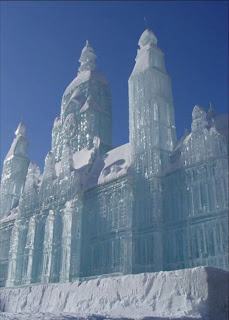An ice sculpture in a park at the annual Harbin Ice and Snow World (Festival) is seen here in Harbin, Northeast China's Heilongjiang Province December 23, 2007. It's the ninth year the Ice City showcases ice sculptures in winter, which sets "Ice World, Olympic Dream" as the theme this year.
People flock to a park to see the ice sculptures at the annual Harbin Ice and Snow World (Festival) in Harbin, Northeast China's Heilongjiang Province December 23, 2007. It's the ninth year the Ice City showcases ice sculptures in winter, which sets "Ice World, Olympic Dream" as the theme this year. [Xinhua]
People visit an ice sculpture named "Olympic Tower" in a park at the annual Harbin Ice and Snow World (Festival) in Harbin, Northeast China's Heilongjiang Province December 23, 2007. It's the ninth year the Ice City showcases ice sculptures in winter, which sets "Ice World, Olympic Dream" as the theme this year. [Xinhua]
An overview of ice sculptures in a park at the annual Harbin Ice and Snow World (Festival) is seen here in Harbin, Northeast China's Heilongjiang Province December 23, 2007. It's the ninth year the Ice City showcases ice sculptures in winter, which sets "Ice World, Olympic Dream" as the theme this year. [Xinhua]
100 ice sculptures melted at Beijing’s Temple of Earth to raise awareness about the estimated one billion lives that will be lost in Asia due to climate change. Greenpeace launched the exhibit of 100 child-sized ice sculptures August 29th, 2009 to highlight the growing concern about water shortages due to climate change. The exhibit was organized 100 days before the Copenhagen Climate Conference in December.
“The future prosperity of India and China is literally melting away,” Yang Ailun added. “With only 100 days to go before the Copenhagen Climate Summit, leaders around the world must take personal responsibility for averting climate chaos and stop the greatest threat to all of humanity.”
The latest scientific research shows that to avert catastrophic climate impacts, global greenhouse gas emissions need to peak by 2015 and decline after that in order to keep global temperature increase below 2°C. Greenpeace urges developed countries, as a group, to agree to cut emissions by 40% below 1990 levels by 2020. Developing countries must reduce their projected emissions growth by 15-30% by 2020. To support these cuts, funding from the developed world of $ 140 billion US dollars a year is needed.
“It’s real concern about climate change impacts like the threat to our water supply that is driving China and India to pursue a low-carbon development path that balances development and environmental protection,” said Greenpeace India Climate and Energy Manager Vinuta Gopal. “If the developed world doesn’t take the opportunity to support developing countries to both adapt to and mitigate climate change, then that balance won’t hold and we will suffer an environmental catastrophe.”
The Temple of Earth used to be where Chinese emperors prayed for the well-being of Earth and good harvests. “We are here today to highlight the catastrophic danger faced by our planet Earth. The disappearance of the Himalayan glaciers threatens the fresh water supply of the one-fifth of the world’s population who live in their watershed. If world leaders don’t agree to stop runaway climate change, children of today will grow up facing a constant struggle to secure reliable access to drinking water,” said Greenpeace China Climate and Energy Campaign Manager Yang Ailun.
has placed ice sculptures of 100 children at the Temple of Earth in Beijing, symbolising the disappearing future of the more than 1 billion people in Asia who are threatened with water shortages by the changing climate.
Ice Sculptures
Subscribe to:
Post Comments (Atom)






















.jpg)

0 comments:
Post a Comment